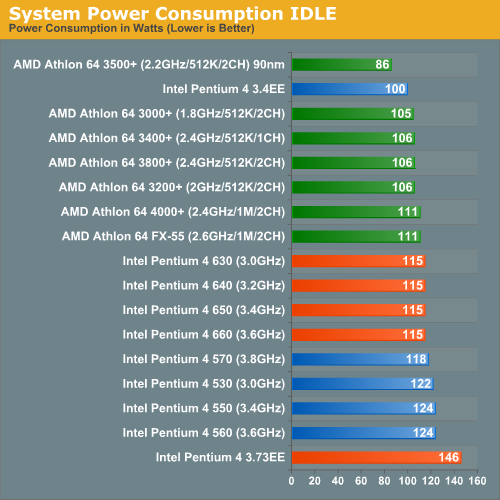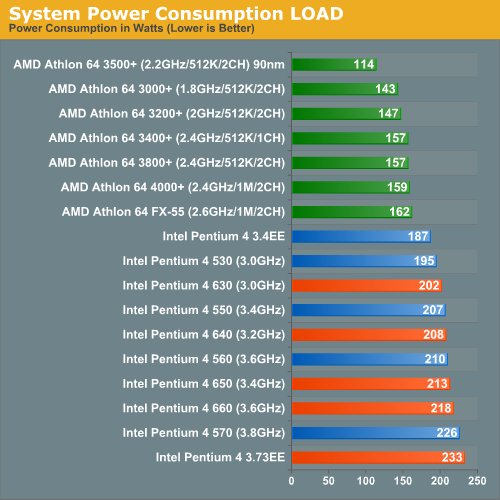Intel Pentium 4 6xx and 3.73EE: Favoring Features Over Performance
by Anand Lal Shimpi & Derek Wilson on February 21, 2005 6:15 AM EST- Posted in
- CPUs
Lower Power Consumption
Over time, any good chip manufacturer will be able to tweak and fine tune their manufacturing process to improve yields. The first 90nm Pentium 4s have been in production for over a year now, and thus it's not too far of a stretch to think that today's 90nm Pentium 4 6xx CPUs are being built on a higher yield 90nm process. In addition to normal tweaks in any manufacturing process, the new 6xx series introduces a handful of power saving techniques that help to reduce overall power consumption of the chip.
First introduced in the 5xxJ series, the Enhanced Halt State (C1E) and Thermal Monitor 2 are both mechanisms included in the 6xx series to reduce power.
Whenever the OS executes the halt instruction, the CPU enters what is known as the halt state. Architecturally what's going on in a halt state is the clock signal is shut off to the CPU for some period of time, with no clock signal none of the logic in the chip will do anything and thus power consumption is reduced. Performance is also significantly reduced, however the halt instruction isn't usually called during application usage, so the performance aspects of the halt state aren't very important.
The problem with the halt state is that it does nothing to reduce voltage, only current draw by stopping clocks from going to the CPU. Since Power varies linearly with both current and voltage (P = I * V), you're effectively only addressing half of the problem. The Enhanced Halt State, as Intel calls it, does two things - it reduces the clock speed of the CPU by decreasing the clock multiplier down to its minimum value (on the 6xx series that's 14x, or 2.8GHz) then reducing the voltage. The clock speed is reduced and then the voltage is dropped, to maintain stability.
Intel insists that the enhanced halt state is a significantly lower power state than the conventional halt state, thanks to the reduction in voltage in addition to the reduction in clock speed. While the standard halt state causes a linear reduction in power, Intel's enhanced halt state causes an exponential decrease in power, potentially offering better power savings than the standard halt state. The real world impact obviously depends on how idle your system happens to be.
When the Pentium 4 was first launched there was a lot of bad journalism out there about how it would overheat and reduce its clock speed significantly thanks its integrated Thermal Monitor. If the Pentium 4 sensed that it was operating outside of safe temperatures, its Thermal Monitor can reduce the effective clock speed of the CPU by approximately 50% - once again by cutting clocks to the CPU. In reality, the Pentium 4's clock throttling never actually came into play unless your fan stopped, or your heatsink fell off. More recent Pentium 4s however have been pushing the thermal envelope further and further, finally to the point where throttling can be a problem if you don't use high quality thermal compound and make sure your heatsink is absolutely secure. The performance reduction when the processor throttles is usually pretty significant.
With the new 6xx series of CPUs, Intel introduces Thermal Monitor 2 (TM2) which, as in the case of the enhanced halt state, reduces clock speed (to 2.8GHz) and voltage as well. The performance impact due to TM2 is much less than the original implementation, so it can actually be triggered during normal use without an overly noticeable loss of performance. However if reducing the clock speed and voltage isn't enough, the CPU will still shut itself down in order to avoid any damage just like the other Pentium 4s did.

Yes, we ran Windows Media Encoder 9 with the fan off for 5 minutes.
But both the Enhanced Halt State and TM2 were introduced in the 5xxJ CPUs, what's new to the 6xx series is the Enhanced Intel SpeedStep Technology (EIST). What EIST does is very similar to AMD's Cool'n'Quiet, it is demand based reduction in CPU clock speed and voltage. Using the same mechanism of adjusting clock speed and voltage, based on the application demand, the Pentium 4 6xx will dynamically increase/decrease its clock speed between 2.8GHz and its normal operating frequency, as well as voltage, in order to optimize for power consumption.
Because of the way EIST (and AMD's Cool'n'Quiet) works, there's inherently a drop in performance. The idea is this - if you're performing a task that's not using 100% of the CPU, the CPU will operate at a slightly reduced frequency in order to conserve power. So while some tasks will require that the system run at full speed, others will run at speeds as low as 2.8GHz. With a minimum multiplier of 14x, slower Pentium 4 6xx CPUs won't get a huge benefit from EIST. For example, the Pentium 4 630 runs at 3.0GHz, meaning the drop down to 2.8GHz isn't really going to conserve a ton of power, nor decrease performance all that much.
AMD's Cool'n'Quiet appears to be more flexible, as it can reduce the clock speed all the way down to 800MHz.
How much of a performance impact does EIST result in? Using a 100% load test such as Windows Media Encoder wouldn't tell us much, as EIST would never really kick in. But something like Winstone where the CPU load is varied, is a much better indication - without EIST, the Pentium 4 660 was approximately 5% faster in Business Winstone than with EIST enabled. Under Doom 3, there was no performance difference.


Intel Officially Adds 64-bit
The Pentium 4 600 series and 3.73EE officially enables Intel's 64-bit extensions to x86 (EM64T, Intel's version of AMD's x86-64). We will have a full look at the 64-bit performance of both AMD and Intel's implementations as soon as Microsoft Windows XP x64 is released.










71 Comments
View All Comments
Alfaneo - Friday, August 26, 2005 - link
here is 478 pin result
Run All Summary
---------- SUM_RESULTS\3DSMAX\SUMMARY.TXT
3dsmax-03 Weighted Geometric Mean = 16.99
---------- SUM_RESULTS\CATIA\SUMMARY.TXT
catia-01 Weighted Geometric Mean = 14.27
---------- SUM_RESULTS\ENSIGHT\SUMMARY.TXT
ensight-01 Weighted Geometric Mean = 20.60
---------- SUM_RESULTS\LIGHT\SUMMARY.TXT
light-07 Weighted Geometric Mean = 12.34
---------- SUM_RESULTS\MAYA\SUMMARY.TXT
maya-01 Weighted Geometric Mean = 18.69
---------- SUM_RESULTS\PROE\SUMMARY.TXT
proe-03 Weighted Geometric Mean = 16.74
---------- SUM_RESULTS\SW\SUMMARY.TXT
sw-01 Weighted Geometric Mean = 14.16
---------- SUM_RESULTS\UGS\SUMMARY.TXT
ugs-04 Weighted Geometric Mean = 18.35
blckgrffn - Thursday, February 24, 2005 - link
Let's hope that they don't post it because they know that running 1T is imperative to get good performance number, and thus use it by default.Hans Maulwurf - Wednesday, February 23, 2005 - link
Many other sites don´t publish their command rate either, this looks very strange for me. Most sites used to publish them before. I don´t understand...L3p3rM355i4h - Wednesday, February 23, 2005 - link
I'm assuming 1T, although the ammount of pwnage that would occur if it was 2T would be incredible.Zebo - Wednesday, February 23, 2005 - link
Derek/Anand- Why is it you don't say what A64's command rate was? 1T or 2T? This makes a huge impact on A64's performance (as shown by Anand right here and myself in forums) and is sloppy jounalism to leave out. Sure "other" sites do this crap but not anandtech.:|Dualboy24 - Wednesday, February 23, 2005 - link
I am just not finding the releases to be impressive lately... I am waiting to see the future dual core etc... perhaps that will wow us all. Its just not like the 90s anymore where it was always an exciting time with CPUs.Perhaps a battle between 56kbps modem models would prove entertaining :) L()L
neogodless - Tuesday, February 22, 2005 - link
#64 I'm saying I don't bother. I don't do that at work (P42.4C) either. At work, I listen to MP3s while having 2 e-mail clients open, various browser windows and tabs, a development environment, FTP, database manager, various IM programs, remote desktop, etc. And I do about the same at home, though usually on a smaller scale. And it works fine. However, if I go to a web page that gobbles up resources (poorly written javascript, i can give you an example page), I'm able to do everything else on the HT machine which shows about "53%" overall CPU usage. An the Athlon 64, if something gobbles up CPU, I see "99%" usage and a sluggish environment. But it's ALL subjective... I want to see Objective measurements.I also don't want to see Athlon vs. Intel opinions/flames because I'm not claiming one or the other is better... just asking for objective measurements.
RZaakir - Tuesday, February 22, 2005 - link
neo, are you saying that you have problems running a game and listening to MP3s simultaneously on your Athlon 64?RockHydra11 - Tuesday, February 22, 2005 - link
Disappointing to say the least....neogodless - Tuesday, February 22, 2005 - link
I'm not sure why I got attacked for requesting Multi-tasking benchmarks. I prefer my AMD for gaming, and I prefer the Intel at work where I run lots of programs at once but (unfortunately) never game. It's not a fair comparison anyway because my home machine is limited by only one monitor, while my work machine has two.Yes, many benchmarks are optimized for Hyperthreading, and if they are synthetic, then it doesn't matter. I'm asking for benchmarks with programs you use every day. If they're optimized for Hyperthreading, then you will see real world benefit from that, when using an HT enabled processor.
When I run games on my AMD64, it gobbles up all the CPU (even if it's an old game) for whatever reason, and I don't find it practical to leave a game running in the background while doing something else. I've done it, and it didn't greatly hinder doing some small task like check e-mail or send an instant message, but I wouldn't intentionally do it, especially if I decided I'd rather listen to Mp3s than finish my game...